Bears Oh My! Community Chat Explores Everything You Need To Know About Bears In Amherst
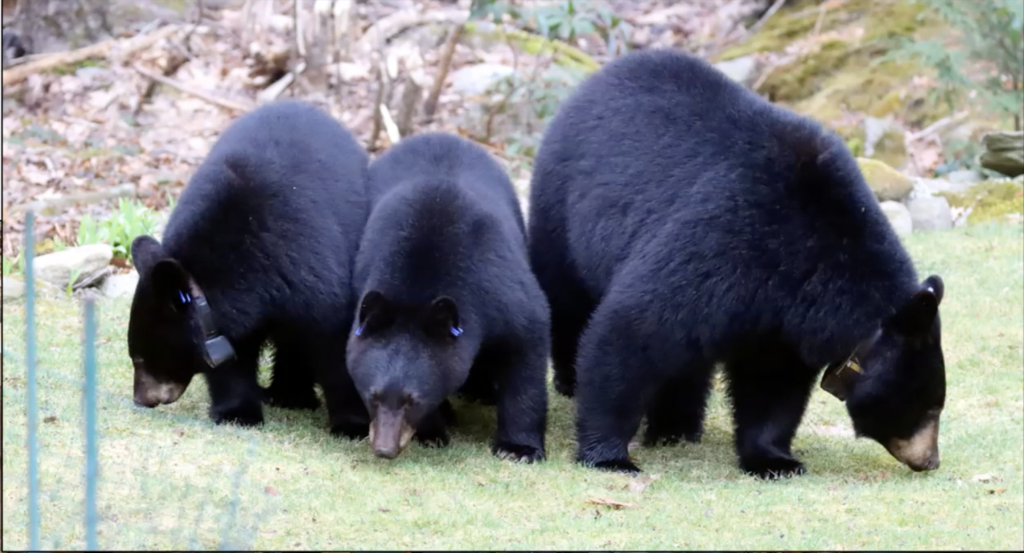
Radio collared mother black bear with cubs. Photo: Dave Wattles
Ninety-five members of the public joined a panel of town officials and wildlife experts on May 4 on Zoom for a community chat focused on bears in Amherst. The panel was organized by Executive Assistant to the Town Manager Angela Mills and District 4 Town Councilor Anika Lopes. They were joined on the panel by Town Manager Paul Bockelman, Town Animal Control Officer Carol Hepburn, and State Fur Biologist Dave Wattles. The first half of the one hour and forty minute chat was devoted to a Powerpoint presentation by Wattles on bear ecology and the prevention of bear/human conflicts. The remainder was devoted to questions from the audience. As the session concluded, it appeared that there were still people in the audience who had questions to ask, and Mills encouraged them to send those questions to getinvolved@amherst.gov and she promised to seek answers. The entire community chat can be viewed here.
Bear/Human Conflict
Wattles emphasized the primary cause of bear/human conflict is over food, and that bears become a nuisance when food sources are readily accessible in people’s yards. These sources may include bird feeders, trash cans, chicken coops, beehives and other forms of backyard farming; but, by far, the most common attraction for bears is bird feeders. Once a bear has been attracted to a feeder it is going to incorporate that yard into its regular foraging routine, and it is best at that point to remove feeders from the property. Feeders are the drivers of conflict. Mother bears will train their cubs to seek out and return to feeders. If we remove the food sources, bears will avoid yards and return to searching for food in a natural area.
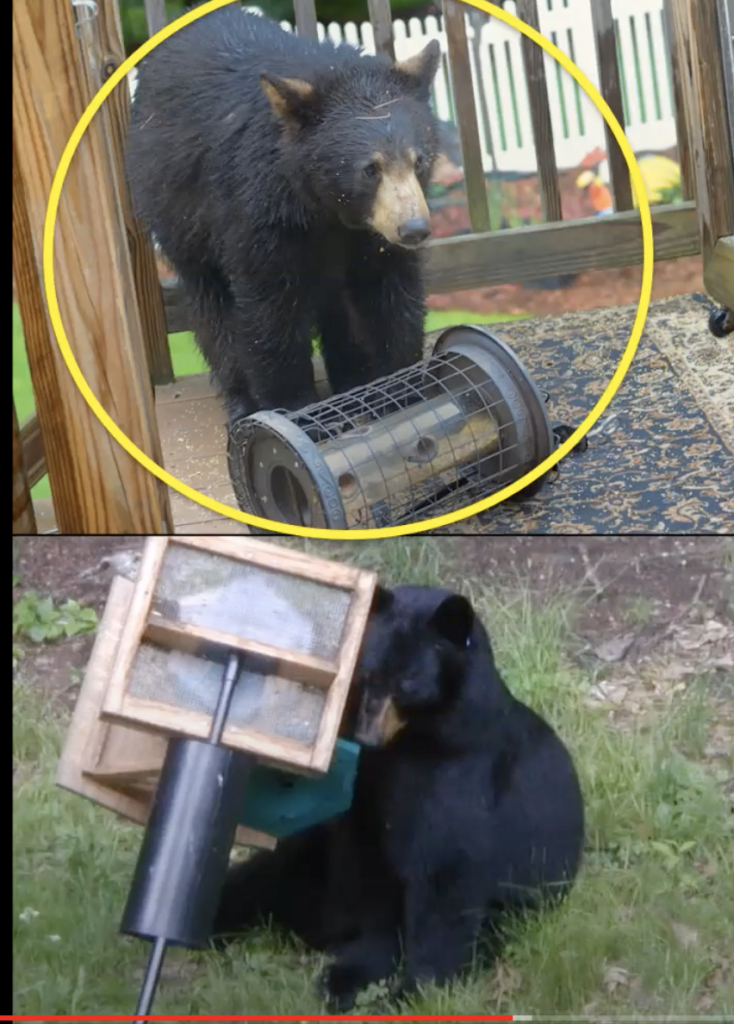
With the growing popularity of backyard chicken farming, chicken coops have also become a source of conflict in Massachusetts. Mass Wildlife encourages those engaged in backyard farming or bee keeping to use electric fencing to keep bears away..
Garbage can be an issue as well. Wattles encouraged people to secure garbage indoors and only put it out the day of pick up, ideally in a container with a secure lid and not just in a plastic bag. Dumpsters can also potentially put folks into dangerous contact with bears. Metal top dumpsters are most effective at keeping bears out, but doors need to be kept closed and latched.
A Bit of Bear Ecology
Breeding season for black bears is April, May and June. Bears mate in the spring but implantation of the embryo is delayed until fall. Sows will give birth every other year, tending to cubs in the interim. Around November 1, pregnant females enter dens and their pregnancy begins to develop. Cubs are born in the den in mid January to February and weigh in at about a pound. They emerge from the den around April 1 and then begin to forage with their mother. Cubs tend to den with the mother in their first year. In second year they disperse during the breeding season
Bears are opportunistic omnivores, meaning they eat just about anything, but roughly 90% of their natural diet is plant based (e.g. grasses, sedges, shoots, lush greenery nuts, berries). They also eat insects and carrion though they don’t actively seek out those foods. They are attracted to human foods when they prove predictably available: including crops (especially corn and apples), and they can cause a lot of damage for farmers. Food preferences change seasonally. In fall, they experience a compulsion to put on weight for winter and especially favor tree mast (e.g. acorns, hickory nuts) and human food at this time. Bears begin to den in October with timing related to food availability and weather. If food is scarce they tend to den later, but if there is a steady food source, they may not den at all. This usually happens when there is a predictable human based food source.
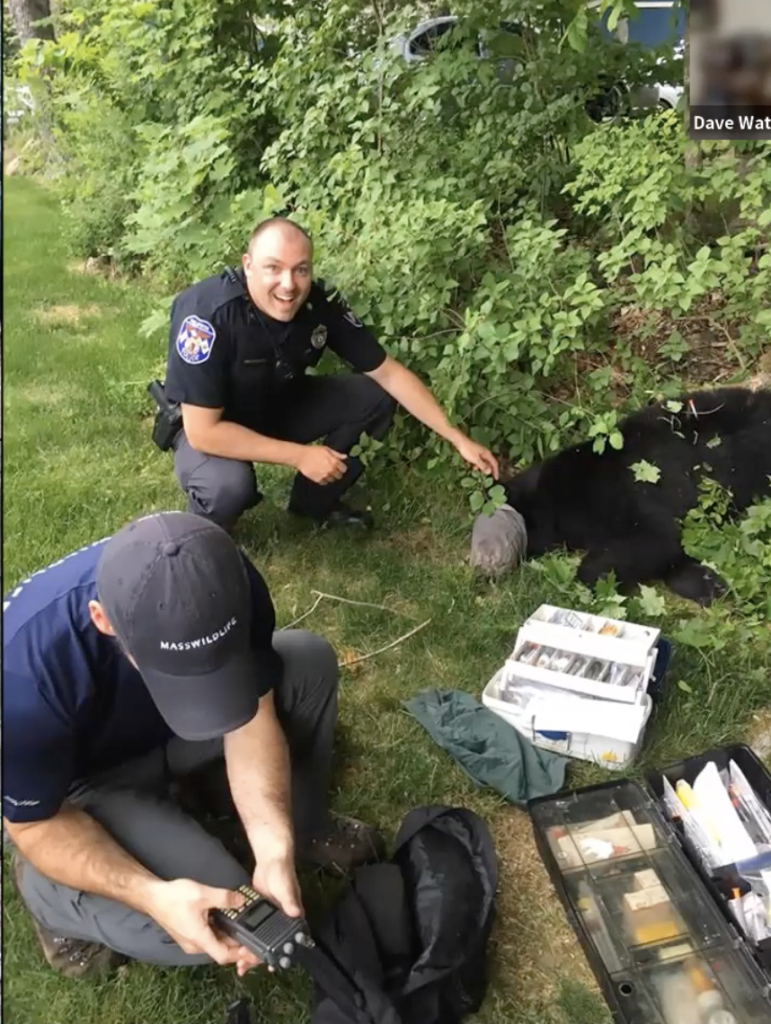
Male black bears in Massachusetts typically weigh up to 600 pounds. Females weigh up to 400 pounds. Rural bears tend to be smaller than urban bears because they are relying primarily on wild food.
The bear population in Massachusetts has grown over time and its range has expanded. Historically bear range extended all the way from the Berkshires to the coast. But this was greatly reduced over time, and by the late 19th century, their range was restricted to a small corner of the northwestern Berkshires. Now the range is expanding again. UMass and Mass Wildlife have been collaring and tracking bears in Massachusetts since the 1980’s,one of the longest continuous studies in the U.S. Females get tracking collars. Males tend to get ear tags as they are difficult to fit with a collar. Hence, we have lots of good information on where they are moving and what they are doing. Currently 34 collared females are being tracked in the state.
Adult female survival rate is very high with most mortality due to hunting or traffic collisions. Wattles estimates that the current population in Massachusetts is four to five thousand bears. He says the state bear population is healthy and growing. Bears can occupy a considerable range as the maps below indicate. Amherst’s bear is active from the UMass campus into Leverett.
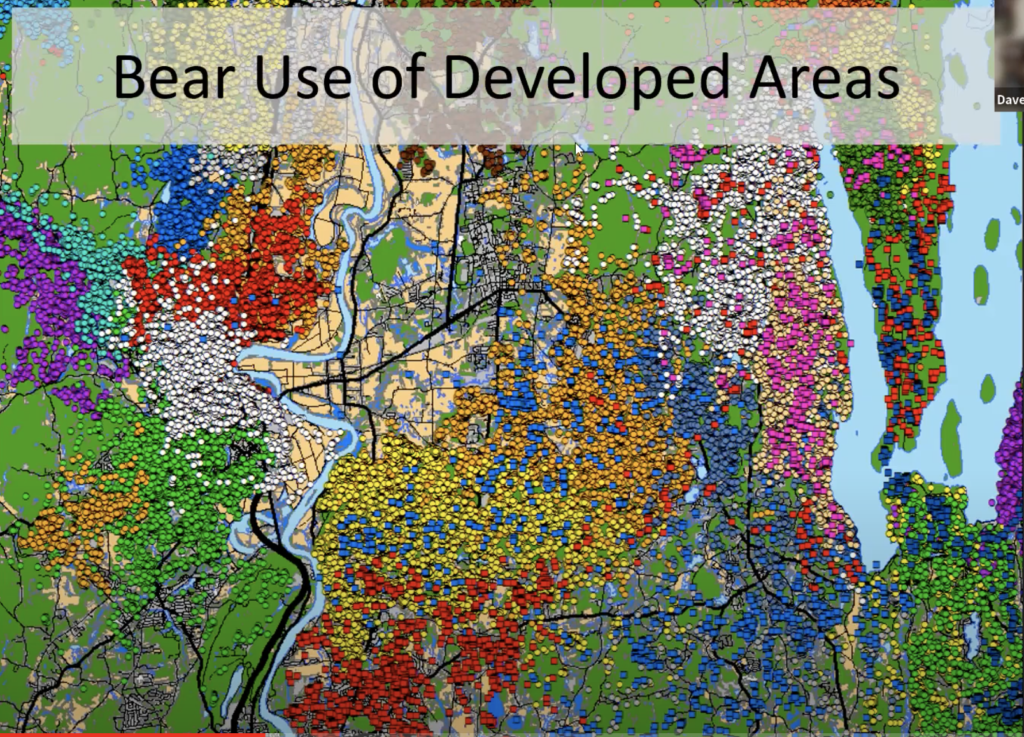
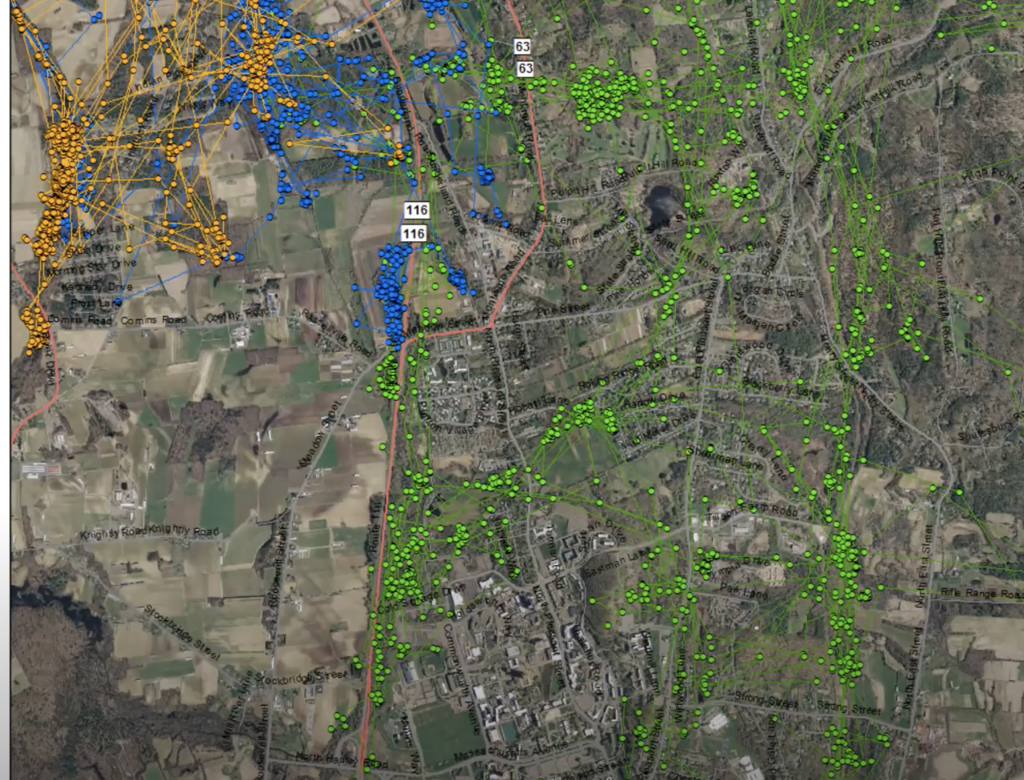
Bears Are Not Aggressive
At multiple points in the chat Wattles emphasized that black bears are not aggressive. He noted that Mass Wildlife has no record of a serious injury to humans from a bear in Massachusetts. But he warned that the more time bears spend around people, the greater chance there is for a negative encounter. He concluded by saying that bears will not change their behavior, so people must. He noted that people could find more information on black bears here and that if people ran into difficulty with a bear they could contact the Massachusetts environmental police 24/7 at 800-632-8075.
Questions (all answers are from Wattles)
Is compost a problem? (Two people noted that bears had rummaged through their compost piles).
We have had hardly any reports of bears getting into compost piles.
I hang vinegar bottles under my bird feeders and take them in at night. Is this effective? Will vinegar deter bears from pillaging the feeders?
I’m skeptical that vinegar would be a deterrent. Bears’ tastes are extremely broad. Data show that bears are as active during the day as at night so it’s better than leaving them out 24/7 but this still poses a problem. He said that you can try these various interventions but once you’ve had a bear on your deck or in your yard you need to take the feeders in or the bear will continue to visit.
Who is going to mate with the female in our area?
That’s hard to know. Males have a huge range and we can’t track them because we can’t fit a collar on them, but there are several roaming around Western Mass right now.
We had a bear and cubs on the deck in Amherst Woods a couple of weeks ago. Can we put out a hummingbird feeder now?
We don’t get a lot of reports on hummingbird feeders but Amherst Woods is adjacent to good bear habitat. If you are attracting bears, then take them down.
Hiking and bears. Is bear spray advisable or necessary?
Most hikers in Massachusetts don’t carry bear spray, which is essentially aerosol pepper spray that can project up to about 20 feet. Black bears in general are not aggressive animals and perhaps only dangerous if they are surprised. It is good to let the animal know you are there by using a calm voice and then slowly back up (and enjoy seeing the bear in the wild).
Can we electrify our bird feeders?
We’d rather you didn’t. Bears have learned that bird feeders are a food source and if they get into an electrified bird feeder it’s just going to train them to not be deterred by other electric barriers.
What’s the ecological value of a bear?
Much to be said here. Probably most important is that they have the intrinsic value of being part of the ecosystem.
What’s the ecological role of humans?
I’m a wildlife biologist, but most of my job is managing people in a human dominated landscape.
Raspberry beds. Do I need to remove them, given bears’ preference for berries in the fall?
Nope. Just try to pick your crop as soon as it’s ripe and remove fruit that has fallen on the ground. Also, berries are quite different from a bird feeder which tends to be seen as a rather permanent and predictable source of food, whereas the interval in which the berries are available is relatively short.
I have birdseed in a can in my garage, mixed with cayenne pepper. A bear came and knocked it over. Are they likely to come back?
It’s possible that they will be deterred by the pepper. But possibly not. They have a pretty good memory of where they have previously found food and so if they regard the seed in the can as potential food, they will likely be back.
What about hot pepper suet?
Maybe. And maybe not. Bears have pretty broad and non-discriminating tastes. Even if they won’t eat it, it may lead them to consider your yard as a known food source.
Dogs off leash. Is this a danger to dogs or bears?
Not a lot. But we did have a report of a bear/dog encounter in South Amherst this week. But negative encounters are uncommon–maybe two a year in the entire state. And almost always it’s the dog that’s initiating the encounter. This is just another reason why you don’t want bears in your backyard. And having your dog on leash also helps prevent a negative encounter.
What do you recommend to encourage bears to move on? We don’t have any food source in our yard but we’ve had bear visitors.
We don’t recommend engaging them. There are only a handful of cases documented of bear/ human contact in the state. Trying to scare them off might spook them and create a negative encounter so it’s better not to do it. But if you do, do it from a safe distance with ready access to indoors.
Is it dangerous to get between a mother bear and her cubs?
That’s not a place where you want to be (but keep in mind that brown bears are aggressive and black bears are not)
I carry an air horn when I work or walk deep in the woods? Is that a good idea?
I recommend against using an air horn or anything that might startle a bear when you are close to it. What you don’t want to do is surprise them. So singing and whistling and talking to yourself is your best bet to make sure you don’t startle them. And you could always wear bells to generate some non-threatening noise. Carrying bear spray is also an option if you are worried.
Are bears common carriers of ticks?
Nearly all wild animals carry ticks, particularly late in the season.
Are there other things the town might be doing to prevent conflict?
You could consider a feeding ordinance. We (Mass Wildlife) can help draft something like this. Both Norhtampton and Springfield have them. It doesn’t necessarily prohibit feeding birds but does restrict feeding when feeders have become an attraction for bears.
What’s the carrying capacity of our area for bears given that we have a female that has just produced three new females?
East of the Connecticut River, a bear territory is about 220 square kilometers. West of the river it’s about a quarter of that. As bear density increases, their ranges get smaller. We are currently tracking seven or eight collared females between Amherst and the Quabbin. Density is increasing. There is potential for it to increase further, and that’s what we think will. Happen.
More Questions?
Send them to getinvolvedW@amherstma.gov

3 thoughts on “Bears Oh My! Community Chat Explores Everything You Need To Know About Bears In Amherst ”